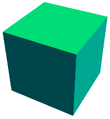Cantor set facts for kids
The Cantor set is a special collection of numbers called a set that mathematicians find very interesting. It has cool features related to shapes, sizes, and how numbers are grouped. For example, it is a fractal, which means it looks the same no matter how much you zoom in. It also has a special "dimension" that isn't a whole number.
The Cantor set has just as many points as all the numbers on a number line, even though it seems like it has less! This property is called uncountability. It means the set is "more infinite" than simply counting 1, 2, 3, and so on. The set is named after Georg Cantor, who first described it in 1883. However, Henry John Stephen Smith actually discovered it earlier, in 1875.
Contents
What is the Cantor Set?
The Cantor set is made by starting with a line segment, like a straight line drawn on paper. Then, you repeatedly remove the middle third of what's left. Imagine you have a line. You cut out the middle part, leaving two smaller lines. Then, you do the same thing to each of those two smaller lines, and so on, forever!
How to Build It Step-by-Step
Let's look at how the Cantor set is built:
- Step 0: Start with a line segment. Imagine it goes from 0 to 1 on a number line.
- Step 1: Remove the middle third. This means you take out the part from 1/3 to 2/3. You are left with two smaller segments: one from 0 to 1/3 and another from 2/3 to 1.
- Step 2: Do the same thing to each of those two segments.
- From 0 to 1/3, remove the middle third (from 1/9 to 2/9). You get segments from 0 to 1/9 and 2/9 to 1/3.
- From 2/3 to 1, remove the middle third (from 7/9 to 8/9). You get segments from 2/3 to 7/9 and 8/9 to 1.
- Step 3: You keep doing this process over and over, an infinite number of times.
The Cantor set is made up of all the tiny points that are left over after you do this process forever. It's a very strange and interesting collection of points!
Cool Facts About the Cantor Set
The Cantor set has some amazing properties that make it special in mathematics:
- It's a fractal: As mentioned, it looks the same no matter how much you zoom in. This is called self-similarity.
- It has no length: Even though it contains an infinite number of points, if you tried to measure its total length, it would be zero! This is because you keep removing more and more length at each step.
- It's "uncountable": This means it has as many points as all the numbers on a number line, even though it looks like just a few scattered points. This is a very deep idea in set theory.
Related Ideas
The Cantor set is connected to other cool mathematical ideas:
- Fractal: Many shapes in nature and math are fractals.
- Set theory: This is the study of collections of objects, like numbers.
- Smith–Volterra–Cantor set: This is another interesting set similar to the Cantor set.
- Menger Sponge: This is a 3D version of the Cantor set.
Images for kids
See also
 In Spanish: Conjunto de Cantor para niños
In Spanish: Conjunto de Cantor para niños



